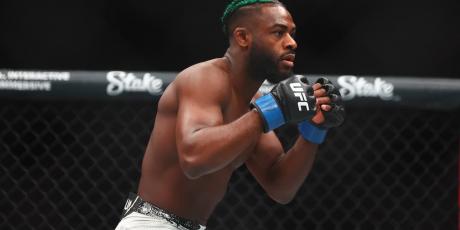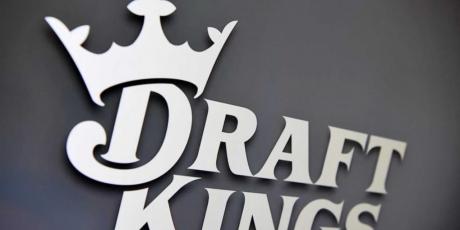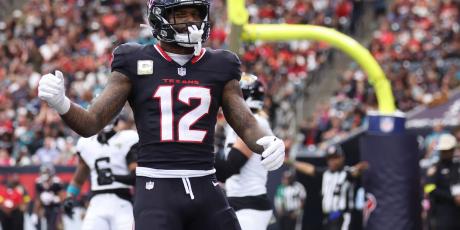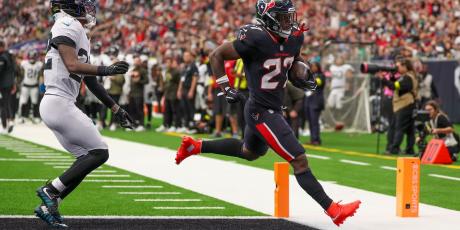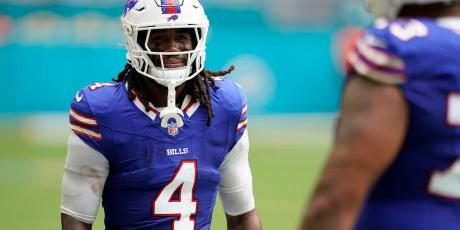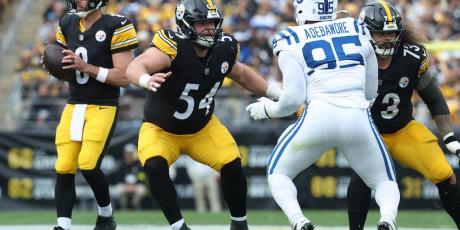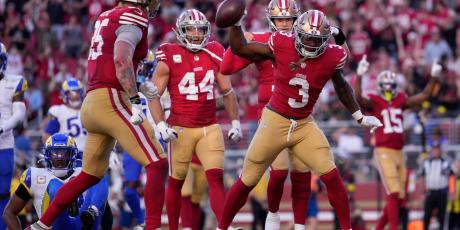Underdog Advance Rates: Wide Receivers

Drafting wide receivers is essentially the meat-and-potatoes portion of drafting in best ball leagues. It makes sense on a basic level; wide receivers accounted for 59% of all targets in 2021. In Underdog leagues, 0.5 points are rewarded for each reception, and at least three wide receivers are rostered on best ball teams each week, with a fourth potentially in the flex spot.
More Underdog Advance Rates: QB | RB | TE
Additional Underdog Resources: Rankings | ADP | Tools | Draft Strategy | Free 4for4 Subscription
As someone who's long been a proponent of drafting early at the position, I believe the overall wide receiver landscape is the most important to understand and review when preparing for best ball drafts. Read on, and we'll take a closer look at the wide receivers with the highest advance rates in 2021 using our Underdog Advance Rate Explorer Tool.
Highest WR Advance Rates
| Player | ADP | Playoffs Advance Rate | Average Player Points | Average Roster Points |
|---|---|---|---|---|
| Cooper Kupp | 4.06 | 48% | 269 | 1660 |
| Deebo Samuel | 6.12 | 33% | 201 | 1613 |
| Mike Evans | 4.01 | 30% | 176 | 1599 |
| Mike Williams | 8.01 | 29% | 149 | 1595 |
| Hunter Renfrow | 17.12 | 28% | 131 | 1600 |
| Chris Godwin | 4.05 | 27% | 173 | 1590 |
| Kendrick Bourne | 18.02 | 25% | 94 | 1577 |
| Justin Jefferson | 2.12 | 25% | 207 | 1588 |
| Van Jefferson | 17.03 | 25% | 100 | 1574 |
| Marquise Brown | 9.02 | 25% | 139 | 1577 |
| Michael Pittman | 9.03 | 23% | 136 | 1571 |
| Ja'Marr Chase | 4.12 | 23% | 181 | 1574 |
Ultimately, it's probably most useful to look at the buckets that the above wide receivers fell into. None of the wide receivers drafted in the first round by ADP were among the top 12 in wide receiver advance rates, despite the fact that all three first-round WRs - Tyreek Hill (1.08), Davante Adams (1.11), and Stefon Diggs (1.11) - ended up among the top 10 WRs in fantasy points per game. If we look at the ADPs of the first trio, we can see that teams drafting them chose to forgo a running back in the first round. If you take a peek at Chris Allen's piece on RB Advance Rates, you'll see that Jonathan Taylor led the position in Advance Rate at 41.4% with an ADP of 1.11. You'll also see Austin Ekeler had a fourth-ranked 28.3% Advance rate at 1.12. So despite the fact that these wide receivers met or exceeded expectations, they often weren't far enough ahead of the field to make up for missing out on those late-first-round running backs.
Justin Jefferson isn't just the only second-round wide receiver to crack the top 12, he's the only second-round wide receiver with an Advance Rate to crack the top 50. He carried an ADP of 2.12, meaning most of the drafters selecting him on Underdog had the 1.01 (or the 1.02,1.03, or 1.04 if they reached for him slightly). In most cases, this would have enabled them to draft one of the top RB options by ADP: Christian McCaffrey, Dalvin Cook, Derrick Henry, and Alvin Kamara. A combo of Justin Jefferson and Derrick Henry had a 34% Advance Rate. Jefferson and Cook: 28%. Jefferson and Kamara: 26%. Jefferson and McCaffrey: Sadface. These drafters had to thread the needle of avoiding McCaffrey AND nearly every single other second-round WR not named Justin Jefferson.
It's notable that there are four receivers on this list with a fourth-round ADP, and not just because I write for 4for4. Cooper Kupp, Mike Evans, Chris Godwin, and Ja'Marr Chase were all parts of prolific passing offenses. Cooper Kupp owes his #1 Underdog wide receiver Advance Rate to his massive target volume. Mike Evans and Chris Godwin's appearances speak to the Tampa Bay Buccaneers passing at the highest rate of any team in 2021, while also operating a Tom-Brady-led offense with the seventh-fastest pace of play.
Ja'Marr Chase was in rarified air as a rookie, owning the 12th-best Advance Rate on a Bengals team that focused 72% of their WR targets on their top two receiving options in Chase and Tee Higgins, the second-most narrowly focused target distribution in the league. This group of fourth-rounders was also among the most heavily targeted wide receivers in the red zone, with the aforementioned Kupp (36 red-zone targets), Godwin (27), and Evans (18) all among the top 12 WRs in targets inside the opponent's 20, and Chase (14) not lagging far behind. Perhaps the best way to look at all this is in table form:
Wide Receiver Advance Rates, Rounds 1-4, 2021
| | POS | ADP | PICK | ADV % | GAMES | POINTS | PPG |
|---|---|---|---|---|---|---|---|
| 1st Round | |||||||
| Tyreek Hill | WR | 8 | 1.08 | 18.4% | 17 | 185.5 | 10.9 |
| Davante Adams | WR | 11 | 1.11 | 21.6% | 16 | 221.3 | 13.8 |
| Stefon Diggs | WR | 11 | 1.11 | 17.0% | 17 | 182.5 | 10.7 |
| 2nd Round | |||||||
| Calvin Ridley | WR | 16 | 2.04 | 8.5% | 5 | 40.1 | 8 |
| DeAndre Hopkins | WR | 17 | 2.05 | 11.5% | 10 | 105.2 | 10.5 |
| DK Metcalf | WR | 20 | 2.08 | 11.9% | 17 | 169.3 | 10 |
| A.J. Brown | WR | 21 | 2.09 | 8.6% | 13 | 117.9 | 9.1 |
| Justin Jefferson | WR | 24 | 2.12 | 25.1% | 17 | 222.4 | 13.1 |
| 3rd Round | |||||||
| Keenan Allen | WR | 27 | 3.03 | 20.7% | 16 | 151.8 | 9.5 |
| CeeDee Lamb | WR | 29 | 3.05 | 15.9% | 16 | 153.8 | 9.6 |
| Terry McLaurin | WR | 30 | 3.06 | 13.8% | 17 | 136.5 | 8 |
| Allen Robinson | WR | 31 | 3.07 | 7.6% | 12 | 49 | 4.1 |
| Amari Cooper | WR | 33 | 3.09 | 15.1% | 15 | 134.5 | 9 |
| 4th Round | |||||||
| Mike Evans | WR | 37 | 4.01 | 30.3% | 16 | 188.5 | 11.8 |
| Robert Woods | WR | 37 | 4.01 | 16.9% | 9 | 92.2 | 10.2 |
| Chris Godwin | WR | 41 | 4.05 | 27.4% | 14 | 144.4 | 10.3 |
| Tyler Lockett | WR | 41 | 4.05 | 18.1% | 16 | 168.4 | 10.5 |
| Julio Jones | WR | 41 | 4.05 | 7.9% | 10 | 49.4 | 4.9 |
| Cooper Kupp | WR | 42 | 4.06 | 48.2% | 17 | 294.5 | 17.3 |
| D.J. Moore | WR | 42 | 4.06 | 15.3% | 17 | 144.5 | 8.5 |
| Ja'Marr Chase | WR | 48 | 4.12 | 22.5% | 17 | 223.6 | 13.2 |
Historical player data is well and good and informative, but if we want to attempt to gain an edge in 2022 Underdog drafts, we need to identify wide receiver profiles and a draft strategy at the position to apply to the current NFL landscape. An 18-round Underdog draft splits up nicely into three six-round sections of early, mid, and late-round selections.
Early Rounds
Let's take a look at those first six rounds and focus on the wide receivers that advanced to the playoffs at the highest rates in Underdog leagues.
| | POS | ADP | PICK | ADV % | GAMES | POINTS | PPG | TARGETS |
|---|---|---|---|---|---|---|---|---|
| Cooper Kupp | WR | 42 | 4.06 | 48.2% | 17 | 294.5 | 17.3 | 191 |
| Deebo Samuel | WR | 72 | 6.12 | 33.3% | 16 | 262 | 16.4 | 121 |
| Mike Evans | WR | 37 | 4.01 | 30.3% | 16 | 188.5 | 11.8 | 114 |
| Chris Godwin | WR | 41 | 4.05 | 27.4% | 14 | 144.4 | 10.3 | 128 |
| Justin Jefferson | WR | 24 | 2.12 | 25.1% | 17 | 222.4 | 13.1 | 167 |
| Ja'Marr Chase | WR | 48 | 4.12 | 22.5% | 17 | 223.6 | 13.2 | 128 |
| Diontae Johnson | WR | 50 | 5.02 | 22.4% | 16 | 167.4 | 10.5 | 169 |
| Davante Adams | WR | 11 | 1.11 | 21.6% | 16 | 221.3 | 13.8 | 169 |
| Keenan Allen | WR | 27 | 3.03 | 20.7% | 16 | 151.8 | 9.5 | 157 |
| Adam Thielen | WR | 49 | 5.01 | 20.1% | 13 | 132.8 | 10.2 | 95 |
If it wasn't already clear, this table should clear away the clouds and demonstrate how important the fourth and fifth rounds were for landing wide receivers with the best advance rates. Excluding Adam Thielen, the low bar for targets in the above group was 114. Every wide receiver in this table is either their quarterback's primary wide receiver, or they are the WR2 for a team that either has a very narrow target distribution, or that spreads the ball around but leans heavily on the pass side of pass/run ratio and pushes the pace of their play. Injuries and non-injury absences certainly played a part in many of the second and sixth-round WRs by ADP that didn't return strong Advance Rates, as six of the 11 players drafted in those rounds didn't play more than 13 games.
The Rams didn't play terribly fast, ranking 21st in pace of play, or call an absurd amount of throwing plays, ranking fourteenth. What they did do was focus absurdly heavily on Cooper Kupp, who averaged 11.2 targets per game, had a 34% market share, and operated as the most-targeted wide receiver in the red zone. The same goes for Davante Adams in Green Bay with his 32.8% market share of targets on a slow-paced run-heavy Packers team. Deebo Samuel also says hello, playing for the fourth-slowest-paced 49ers who passed the second-least, but devoted a sizeable 28.2% of their wide receiver targets to Deebo. Ja'Marr Chase might be the most intriguing among these wide receivers that played for this team archetype. The Bengals called plays at the third-slowest pace, and were middle-of-the-pack in passing play percentage, but 72% of the team's targets went to Chase and Tee Higgins, and Chase is entering his sophomore season which has been shown to be the most likely season for a wide receiver to improve on a previous year's output.
Mike Evans and Chris Godwin were on the lower end of their market share of Tampa Bay's WR targets at 16.7% and 21.4% respectively, but Tampa Bay was No. 1 in passing percentage and operated at the league's fastest pace. The Vikings' Justin Jefferson and Adam Thielen came close to having their team check all three boxes of pace (10th), passing percentage (16th), and focused target distribution, concentrating 71% of their total WR targets on their top two receiving options.
Diontae Johnson and Keenan Allen both played for teams that were in the top half of the league in all three categories, but only Pittsburgh hit the trifecta, finishing top-10 in all three areas in pace of play (6th), passing percentage (2nd), and focused target distribution (6th). Johnson's 28.8% market share of targets for a Steelers team that averaged 25.1 seconds per play and passed 64% of the time made up for Ben Roethlisberger's 3.4 air yards per attempt, a likely indicator of his declining arm strength in his final season. Along with his third-round ADP, the Chargers' wider target distribution was the most likely culprit for Keenan Allen not finishing with a higher Advance Rate.
Considering how many excellent wide receivers were available in the fourth and fifth rounds, an RB-focused approach for the first couple of rounds starts to make a lot of sense. It makes even more sense when considering the unprecedented movement of the top wide receivers in the league between teams this offseason, making some of the traditional first or second-round locks at the position more difficult to project. If you haven't read 4for4's own TJ Hernandez's piece on Best Ball Mania Positional Draft Strategies, shame on you, go rectify that. TJ's findings on the success of a "Superhero-RB" draft strategy, which involves drafting RBs with your first two picks and then avoiding them until the eighth round (or later), should also apply to regular Underdog best ball leagues. It also lines up perfectly with targeting this ADP range of wide receivers.
Favorite Early-Round Targets: Mike Williams (3.05), Michael Pittman (3.07), Courtland Sutton (4.01), Allen Robinson (4.11), Rashod Bateman (5.05)
Middle Rounds
| | POS | ADP | PICK | ADV % | GAMES | POINTS | PPG |
|---|---|---|---|---|---|---|---|
| Mike Williams | WR | 85 | 8.01 | 29% | 16 | 170.6 | 10.7 |
| Marquise Brown | WR | 98 | 9.02 | 25% | 16 | 135.3 | 8.5 |
| Michael Pittman | WR | 99 | 9.03 | 23% | 17 | 150.6 | 8.9 |
| Jaylen Waddle | WR | 95 | 8.11 | 22% | 16 | 141.8 | 8.9 |
| Elijah Moore | WR | 113 | 10.05 | 20% | 11 | 95.2 | 8.7 |
| Cole Beasley | WR | 133 | 12.01 | 19.2% | 16 | 77.3 | 4.8 |
| Antonio Brown | WR | 82 | 7.10 | 18.9% | 7 | 79.1 | 11.3 |
| Brandin Cooks | WR | 91 | 8.07 | 19% | 16 | 141.8 | 8.9 |
| DeVonta Smith | WR | 75 | 7.03 | 19% | 17 | 121.6 | 7.2 |
| Darnell Mooney | WR | 101 | 9.05 | 18% | 17 | 138.7 | 8.2 |
Barring some obvious "We Don't Talk About Bruno" pass-taking here with Antonio Brown and Cole Beasley, the middle rounds offered some very intriguing WR options. A lot of these receivers fell into this range either due to specific unknowns or knowns. The natural unknown of the transition to the NFL for rookies Jaylen Waddle, Elijah Moore, and DeVonta Smith. The unknown of rookie QB Justin Fields for Darnell Mooney. The known element that Marquise Brown was in an extremely run-heavy offense that was also slow-paced. The known injury risk that Brandin Cooks presented with five concussions in six seasons along with the unknown of the Texans' starting QB situation with Deshaun Watson benched. The known of Michael Pittman not breaking out as a 2020 rookie and having Carson Wentz as his QB. The unknown for rookie receivers is certainly exploitable by researching the production profiles of rookie wide receivers like Jaylen Waddle and Elijah Moore in conjunction with their draft capital and the offensive tendencies of the teams that drafted them.
The "known" qualities can also be exploitable. As evidenced by the wide receivers with some of the top win rates in 2021, as long as a team like Baltimore acutely focuses their target share, slow and run-heavy aren't the kiss of death for a mid-round wide receiver. Neither is non-elite quarterback play, again as long as the team narrowly focuses its target distribution on one or two wide receivers.
Mike Williams 2021 ADP made the least sense in retrospect. He'd already had a 1,000-yard season prior to the addition of Justin Herbert in 2020, and despite a somewhat disappointing 2020 with rookie QB Herbert, he still had a 14.5 aDOT in that ranked 14th among all wide receivers. In 2021, Williams was the other beneficiary of the Chargers' league-leading pace of play and heavy reliance on the passing game alongside Keenan Allen, but his 11.6 aDOT was the highest on the team. Only 10 wide receivers garnered more red zone targets than Williams with 22, and though teammate Keenan Allen was one of them with 27, Williams still managed to haul in nine touchdowns to Allen's six.
Favorite Middle-Round Targets: Michael Thomas (7.03), Russell Gage (7.06), Treylon Burks (7.08), Skyy Moore (8.08), Tim Patrick (10.11), Jakobi Meyers (12.03)
Late Rounds
| | POS | ADP | PICK | ADV % | GAMES | POINTS | PPG |
|---|---|---|---|---|---|---|---|
| Hunter Renfrow | WR | 204 | 17.12 | 28% | 16 | 192.7 | 12 |
| Kendrick Bourne | WR | 206 | 18.02 | 25% | 16 | 148.3 | 9.3 |
| Van Jefferson | WR | 195 | 17.03 | 25% | 16 | 139.1 | 8.7 |
| Christian Kirk | WR | 166 | 14.10 | 22% | 16 | 163.8 | 10.2 |
| Jalen Guyton | WR | 205 | 18.01 | 22% | 15 | 73.5 | 4.9 |
| Scott Miller | WR | 206 | 18.02 | 20.9% | 7 | 4.9 | 0.7 |
| A.J. Green | WR | 166 | 14.10 | 20.5% | 15 | 125.5 | 8.4 |
| Zach Pascal | WR | 204 | 17.12 | 20% | 15 | 74.3 | 5 |
| Allen Lazard | WR | 196 | 17.04 | 20% | 14 | 100.5 | 7.2 |
| Randall Cobb | WR | 161 | 14.05 | 19% | 12 | 79.6 | 6.6 |
It's a bit simple to say that this stage of the draft is a crapshoot, so you might as well aim for upside, but this stage of the draft is a crapshoot, so you might as well aim for upside. Rounds 13, 14, and 15 were an injury-riddled mess in 2021. 67% of the 18 wide receivers drafted among these three rounds played in 12 or fewer games. While this isn't really actionable for 2022 drafts, there are some examples in the list above of wide receiver profiles we want to aim for at this stage.
Slot receivers offered very strong returns in this ADP range. Hunter Renfrow had the highest target rate among Raiders wide receivers in 2020, and the team lost Nelson Agholor to free agency prior to the 2021 season, the only WR on the team to out-target him. Las Vegas had a wide target distribution, but they passed at one of the higher rates in the league and were decently paced at 26.5 seconds per snap. Kendrick Bourne was a new addition to the Patriots following a 74-target, 667-yard season in 2020 with San Francisco, but he appeared to be at best fourth on the receiving depth chart with a rookie QB at the helm.
Christian Kirk became Arizona's primary receiving option despite lining up in the slot for 78% of his offensive snaps when DeAndre Hopkins suffered injuries throughout the season. Zach Pascal averaged 7.2 points per game and lined up in the slot 72% of the time. Randall Cobb in his 12th season averaged 6.6 points per game primarily as a slot option in the Green Bay offense. Full disclosure, I have no idea how or why Scott Miller had a 20.9% Advance Rate, but it certainly had nothing to do with his statistical output.
Favorite Late-Round Targets: Jalen Tolbert (13.01), George Pickens (14.07), Curtis Samuel (15.09), Kendrick Bourne (16.09), Donovan Peoples-Jones (18.01), Isaiah McKenzie (18.04)
Bottom Line
- Wide receivers going in the first round in 2022 are more difficult to project than usual with so much offseason movement, and even in a more normal 2021 season, they didn't return elite Advance Rates.
- Spend some extra time on the receivers being drafted in the fourth and fifth rounds, especially if implementing a Superhero-RB build.
- Focus less on the names and more on the team situations that wide receivers operate in. Ideally, target receivers on teams that pass the most frequently at the fastest pace and have a narrow target distribution. That being said, don't ignore WRs on teams that are slow-paced or run-heavy (or both), as long as they focus their targets on their top one or two wide receivers.
- In the middle rounds, try to use the perceived "knowns" and "unknowns" to your advantage. Rookies in this range have clear upside, as do veterans whose ADP is depressed due to circumstances outside of their production profile.
- In the late rounds, aim for slot receivers, especially WRs on teams with a thin depth chart, and again on teams with incumbent coaching staffs with the same offensive tendencies I've focused on throughout.


